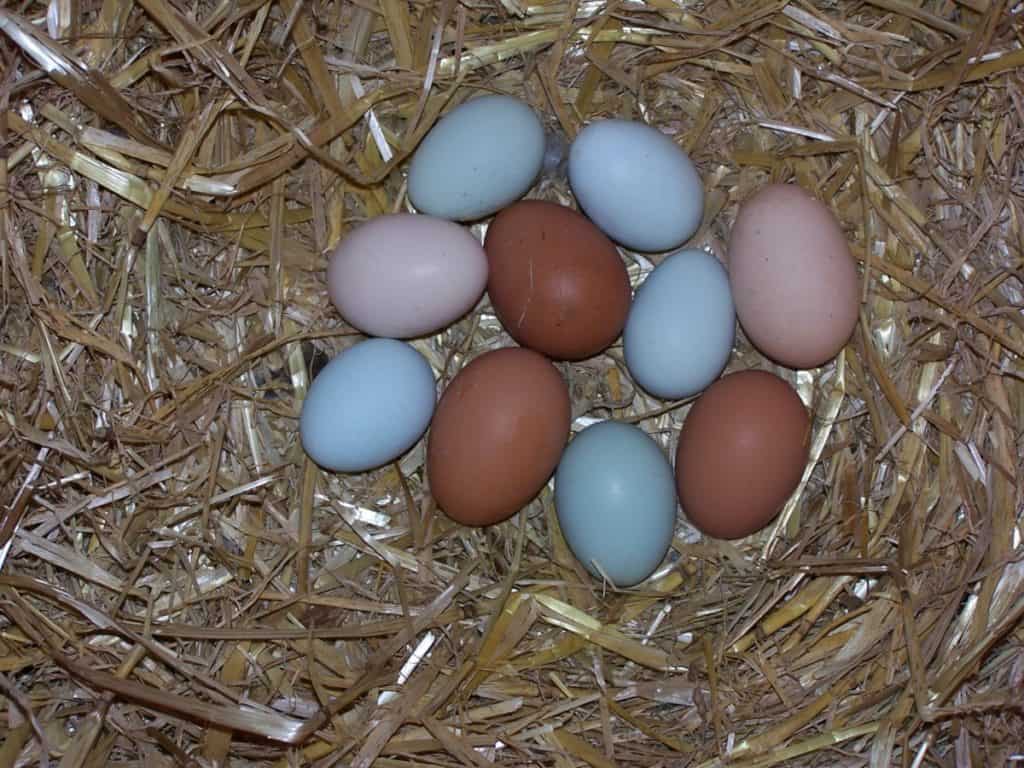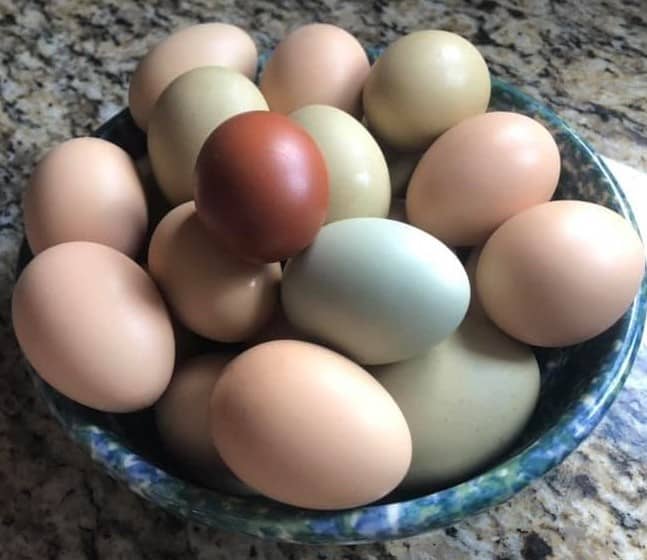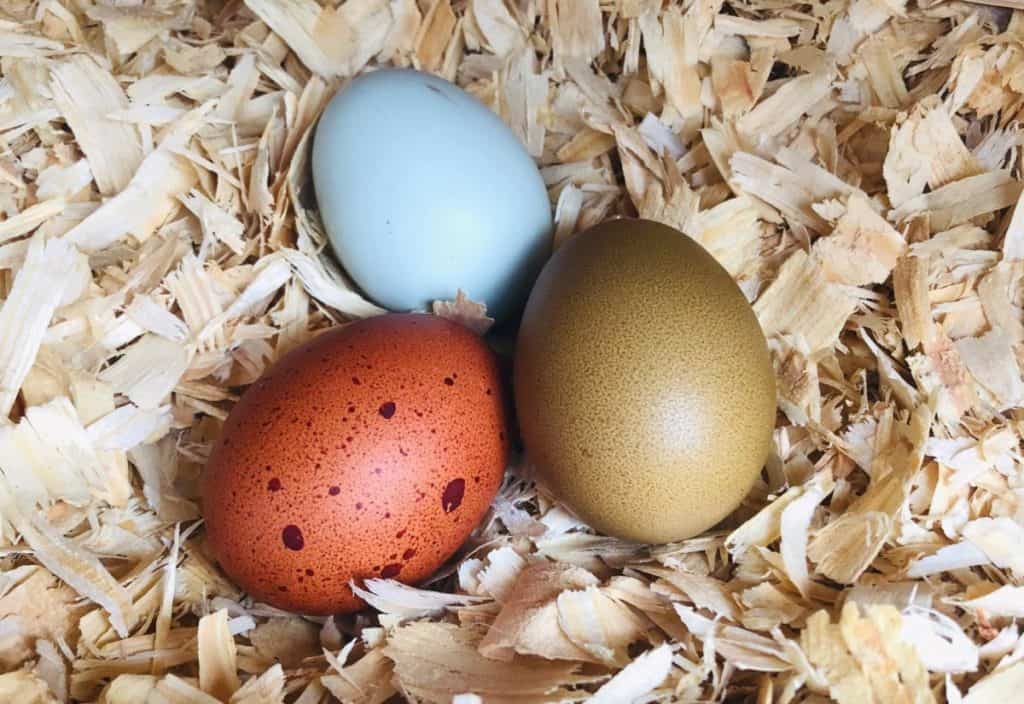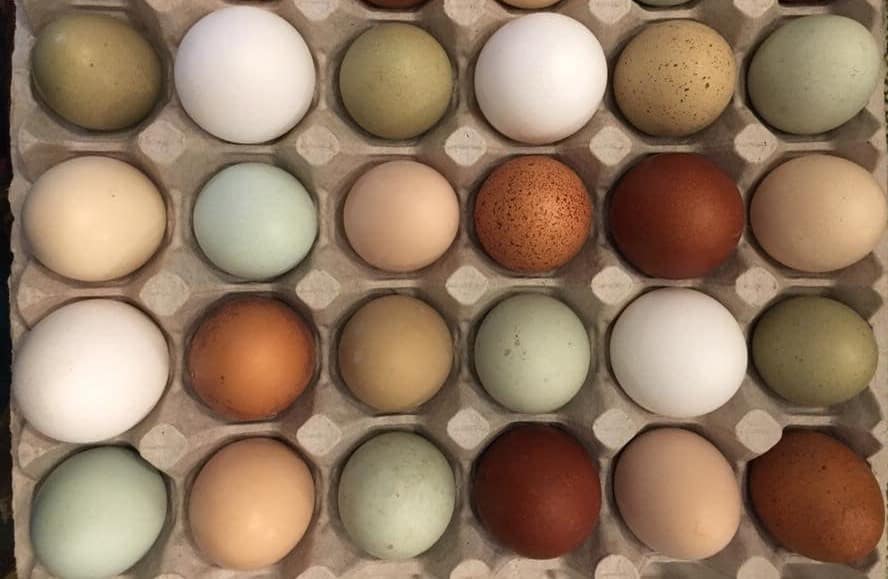Most people think that chickens only lay two color eggs; brown and white. There are, in fact, a whole host of other color eggs that chickens can lay.
Chickens can lay a variety of different colored eggs from white to almost black. The color is determined by the breed and genetics of the chicken. In many chickens, you can tell the color of the eggs by looking at the color of the chicken’s ear lobes.
There are some chickens that do not follow this rule, such as Silkies.
Welcome to the wonderful world of multi-colored chicken eggs. It seems to have been a carefully hidden secret that chickens can lay a wide assortment of different colored eggs.
Let’s investigate this phenomenon and find out what influences the color of the eggs.
- Can Chickens Lay Different Colored Eggs?
- Which Chickens Lay Each Color Of Egg?
- How Can You Tell What Color Eggs A Chicken Will Lay?
- What Determines The Color Of Eggs?
- Does The Egg Shell Color Affect The Taste Of The Egg?
- Can The Rooster Determine The Egg Color?
- Are There Purple Eggs?
- Do Black Chickens Lay Black Eggs?
- What Color Eggs Does An Olive Egger Lay?
- Is There Any Reason A Chicken’s Eggs Will Change Color?
- Conclusion

Can Chickens Lay Different Colored Eggs?
Chickens lay brown and white eggs that are familiar to us all. They can also lay blue, green, pink, olive, and dark brown or chocolate eggs.
Chicken breeds have different genetics and thus produce different colored eggs.
Which Chickens Lay Each Color Of Egg?
White Leghorns are the most prevalent type of layer hens, and they lay white eggs.
Some other breeds only lay white eggs. These are:
- Andalusians
- Lakenvelders
- Polish Hens
- Anconas
- Hamburg hens
Brown eggs are also commonly seen in our egg boxes in the shops. The following breeds lay brown eggs:
- Orpingtons
- Plymouth Rocks
- Australorps
- Plymouth Barred Rocks
- Rhode Island Reds
- Sussex hens
- Wyandottes
Dark chocolate-colored eggs are laid by:
- Marans – also sometimes called chocolate eggers
- Barnevelders
- Penedesencas
- Empordanesa
- Welsummers
Blue egg layers are:
- Ameraucanas
- Araucanas
- Easter Eggers
- Cream Legbars
Green eggs are laid by:
- Olive Egger chickens lay bright olive-colored eggs. These chickens were developed by crossing Ameraucanas and Maran chickens.
- Favaucanas are a new breed that was developed by crossing Faverolles with Ameraucanas. These chickens lay pale sage green eggs.
- Easter Eggers are mixed breed chickens that have Ameraucanas or Araucanas in their heritage.
- Isobars lay mint green eggs.
Pink eggs or creamy pink eggs are laid by:
- Light Sussex
- White Australorps
- Mottled Javas
- Buff Orpingtons
- Easter Eggers
- Faverolles
- Some Silkies

How Can You Tell What Color Eggs A Chicken Will Lay?
As odd as it sounds, you can tell the color eggs a hen will lay by examining the color of her earlobes. A chicken’s ears are situated just to the back of the eyes but are covered by feathers. Just below this is a fleshy appendage which is the chicken’s earlobes.
A chicken with white earlobes will lay white eggs. A chicken with brown or reddish-brown lobes will lay brown eggs. Even chickens that lay blue eggs have blue ear lobes.
There are exceptions, such as Silkies that have blue lobes but lay white eggs and some hybrid breeds whose earlobes do not match the color of their eggs.
What Determines The Color Of Eggs?
The chicken’s genetic inheritance determines egg color. Hens have different colored pigments in their body. The same pigment which determines the color of the egg also often corresponds to the color of the chicken’s ear lobes but it is not 100% accurate depending on the breed.
Blue-colored eggs are caused by the deposition of the pigment biliverdin into the eggshell. Biliverdin is the same pigment that makes your bruises go a blue-green color.
Blue eggs are blue both on the inside and outside of the shell. The pigment is released into the oviduct high up in the channel as the egg forms, resulting in the entire shell being blue.
Brown eggs are white on the inside. They are produced by the pigment protoporphyrin, which is the pigment that makes blood red.
The eggshell develops from white calcium carbonate, and the pigment is only released towards the end of the oviduct. The pigment, therefore, only colors the outside of the shell.

Does The Egg Shell Color Affect The Taste Of The Egg?
Scientists have studied different colored eggs and have concluded that the color of the eggshell does not affect the taste or nutritional quality of the egg in any way. The taste and nutritional quality are determined by the chicken’s diet and living conditions.
Can The Rooster Determine The Egg Color?
Roosters do not have any effect on egg color. It is only the pigment in the hen’s body that determines the color of the egg. You can use a rooster to cross-breed and produce a hen that lays different colored eggs.
Are There Purple Eggs?
Unfortunately, there are no truly purple eggs. Eggs that appear purple are usually brown, and the bloom (cuticle) of the egg makes them appear purple.
Do Black Chickens Lay Black Eggs?
The blackest chickens are Ayam Cemani. They have black feathers, feet, combs, and a black beak. Even the skin and flesh of Ayam Cemanis are black, but they lay cream-colored eggs.
Other black chickens are Marans which lay chocolate-colored eggs. Black Australorps lay brown eggs. The only bird that lays black eggs is an emu.

What Color Eggs Does An Olive Egger Lay?
Olive eggers lay bright olive-colored eggs. The egg has an underlying blue color in the shell laid down higher in the oviduct.
The blue shell is overlaid by protoporphyrin as the eggs near the end of the oviduct. Thus, brown pigment overlays the blue creating an olive-colored egg.
Is There Any Reason A Chicken’s Eggs Will Change Color?
Stress, disease, and extremely hot weather can sometimes affect the color of a chickens’ eggs. The color will not be dramatic – for example, a chicken that lays brown eggs will not suddenly lay white eggs.
The color change would be to make the egg paler or darker, or there may be some white streaks or splotches on the shell. These changes are caused by the egg being retained for longer in the oviduct.
An increase or decrease in calcium content in the shell can cause imperfections in color.

Conclusion
You can tell the color of the eggs that your chicken will lay by looking at some different factors. The breed of chicken influences the color of the eggs as the color is genetically determined.
Generally, it is possible to tell the color of the eggs by looking at the color of the hen’s earlobes. There are some exceptions to this rule. Minor changes in egg color can occur when the hen is stressed, diseased, or the environmental temperatures are very high.
Alternatively, you can wait until your hen starts producing eggs and be surprised by what you find in the nesting boxes.

